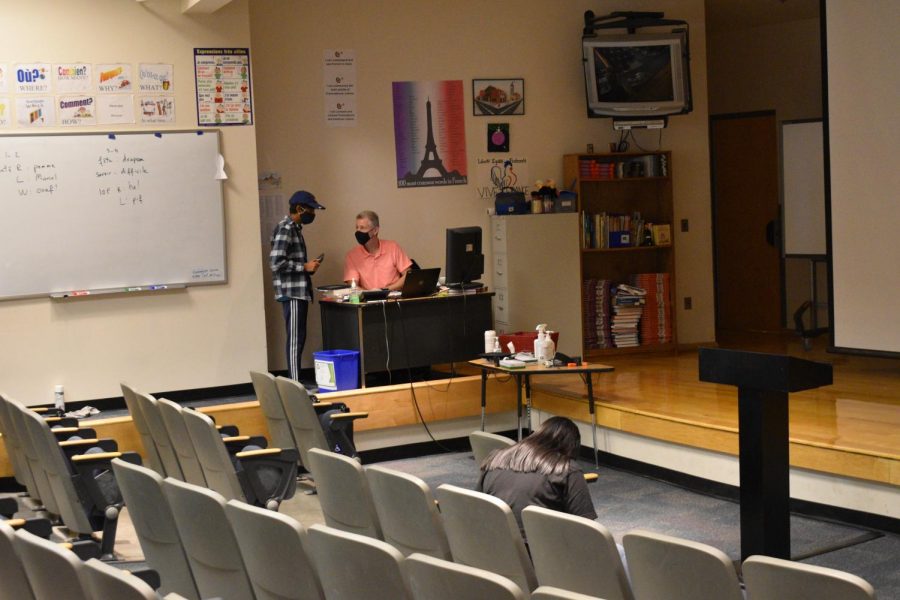Teachers boost learning in new classrooms
Mr. Candela talks to one of his students during tutoring.
July 14, 2021
OHS’s classrooms are spread out in several buildings, and as its student enrollment grows, school administrators and teachers have had to get creative with what can be considered a classroom. From the mini-auditorium to the faculty dining hall, students are learning to use unique approaches in unconventional locations.
New spaces, like the mini-auditorium and faculty dining hall, are not like typical classrooms. Teachers have to come up with inventive solutions to unexpected issues. Although there are downsides, the new spaces are usually much larger than a regular classroom and teachers have more room to get innovative and original with their lessons and activities. The additional space also comes as an unforeseen benefit during the COVID-19 pandemic, especially since a typical classroom does not always have enough space for social distancing.
“Being in the mini-auditorium, the first thing that annoyed me a little bit is that I wouldn’t be able to move the chairs to the side of the room like we were doing previously to do all our moving around activities,” said Michel Candela, French teacher. “But because there is the stage and there’s enough room around all the seats [it has worked out].”
Many teachers believe that having students sitting in their seats the entire class period is not always the best way to teach. Candela uses many activities that involve students moving around and getting out of their seats for this reason.
“It depends on the level, but I know that with French 1-2 I have a lot of activities where they move around, run around, [and] work in pairs,” Candela said. “A lot of activities like that, where students are not just staying on their seat but moving around [is better]; the blood needs to flow, this is one of the keys [to] teaching.”
Other teachers believe that allowing students to get up from their seats can help students focus on their studies.
“I believe in what is called movement-driven learning and if we can keep our bodies in motion it improves our cognition, and so a lot of the lessons I do, you’ll see our kids up and active,” said Dr. William Hesse, health teacher. “I like to keep the students moving, on their feet as much as possible, which also increases engagement, and in the end, if you can increase engagement and increase cognition, your test scores will [rise].”
Hesse believes that his large classroom in the faculty dining hall gives his students more opportunities to get up from their desks, which, in turn, can help them learn more efficiently and can help him cater to each of his students’ needs.
“There is more room to do things, there’s more room to be active, to do different projects, to [have] a more hands-on approach style of learning for each student,” Hesse said. “We differentiate to each student’s learning, but with more space we are able to increase that.”
The new classrooms also come with added bonuses that the teachers can enjoy, like private bathrooms and daylight coming in from windows.
“I like the fact that I can see daylight, because this [was] something that [was] hard for me,” Candela said. “For the seven previous years I worked at Sandra Day O’Connor, I was in a room that there was absolutely no windows, so for the whole day I didn’t see light at all, [but] here I can see it from [my desk], [and] if I open this door I could even step outside.”
Despite the advantages to having a generously-sized room, there can be drawbacks that can inconvenience both students and teachers alike.
“Due to COVID-19 and a lack of space, we can no longer do as many interactive activities, and most of the time we sit very far apart,” said Samantha Kennan, sophomore and french student. “I don’t enjoy it personally because I am very far away from the teacher most of the time; I have a hard time hearing what he is saying and seeing what he is writing on the board.”
Teachers try to accommodate students’ needs as much as possible, but due to the safety measures implemented because of COVID-19, it can still be difficult for both groups.
“I use the microphone, and I think everyone can hear me with that, [and] for seeing what is on the board, I try to write a bit bigger but I always have students that tell me when it’s too small,” Candela said. “The issue is not always that the students need to hear me, or be able to read [the board], it’s that I need to be able to hear them, and with the mask and the distance that is kind of difficult for me.”
Having classrooms in spaces that are not meant for teaching can bring inconveniences when the space’s original purpose is needed.
“One of the inconveniences is that sometimes the mini-auditorium is used by people from the outside, not really during COVID-19, but they could [still] just come here,” Candela said. “People that [I] don’t know come here and use the place, so [I] have to put all [my] stuff away, lock it, be sure that nothing’s going to disappear.”
The bizarre classroom spaces may come with their permanent advantages and disadvantages, but in the short-term, the extra space can help keep students and teachers safe.
“I do believe [the mini-auditorium] is much safer for COVID-19,” Kennan said. “A lot of classrooms, even though teachers are doing their best to spread the students out, are still overcrowded and still a hazard to health; in the mini we are very spread out, we have a lot of distance between students, and I think that impacts how many people have got COVID-19.”




